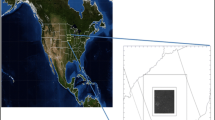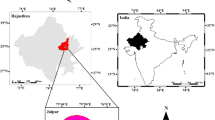Abstract
Forest fire is a serious disaster all over the world. The Fire Weather Index (FWI) System can be used in applied forestry as a tool to investigate and manage all types of fire. Relative humidity (RH) is a very important parameter to calculate FWI. However, RH interpolated from meteorological data may not be able to provide precise and confident values for areas between far separated stations. The principal objective of this study is to provide high-resolution RH for FWI using MODIS data. The precipitable water vapor (PW) can be retrieved from MODIS using split window techniques. Four-year-time-series (2000–2003) of 8-day mean PW and specific humidity (Q) of Peninsular Malaysia were analyzed and the statistic expression between PW and Q was developed. The root-mean-square-error (RMSE) of Q estimated by PW is generally less than 0.0004 and the correlation coefficient is 0.90. Based on the experiential formula between PW and Q, surface RH can be computed with combination of auxiliary data such as DEM and air temperature (T a). The mean absolute errors of the estimated RH in Peninsular Malaysia are less than 5% compared to the measured RH and the correlation coefficient is 0.8219. It is proven to be a simple and feasible model to compute high-resolution RH using remote sensing data.
Similar content being viewed by others
References
Chesters D C, Uccellini L W, Robinson W D, 1983. Low-level water vapor fields from the VISSR Atmospheric Sounder (VAS) ’split-window’ channels. Journal of Applied Meteorology, 22(5): 725–743.
Chrosciewicz Z, 1978. Slash and duff reduction by burning on clear-cut jack pine sites in central Saskatchewan. In: David R (ed.). Information Report of Northern Forest Research Centre. Edmonton: Canadian Forestry Service Press, NOR-X-200.
Fraser R S, Kaufman Y J, 1985. The relative importance of aerosol scattering and absorption in remote sensing. IEEE Transactions on Geoscience and Remote Sensing, 23(5): 525–633.
Frouin R, Deschamps P Y, Lecomte P, 1990. Determination from space of atmospheric total water vapor amounts by differential absorption near 940nm: theory and airborne verification. Journal of Applied Meteorology, 29(6): 448–460.
Fyles J W, Fyles I H, Feller M C, 1991. Forest floor characteristics and soil nitrogen availability on slash-burned sites in coastal British Columbia. Canadian Journal of Forest Research, 21(10): 1516–1522.
Gao B-C, Goetz A F H, 1990. Column atmospheric water vapor and vegetation liquid water retrievals from airborne imaging spectrometer data. Journal of Geophysical Research, 95(4): 3549–3564.
Gao B-C, Kaufman Y J, 2003. Water vapor retrievals using moderate resolution imaging spectroradiometer (MODIS) near-infrared channels. Journal of Geophysical Research, 108(13): 1–9.
Han Kyung-Soo, Viau A A, Anctil F, 2003. High-resolution forest fire weather index computations using satellite remote sensing. Canadian Journal of Forest Research, 33(6): 1134–1143.
Ivan P Anderson, Ifran D Imanda, Muhnandar, 1999. Vegetation fires in Sumatra, Indonesia: A first look at vegetation indices and soil dryness indices in relation to fire occurrence. In: European Union Ministry of Forestry and Estate Crops (ed.). Forest Fire Prevention and Control Project Report. Palembang: Kanwil Kehutana dan Perkebunan Press, 2–4.
Kaufman Y J, Gao B-C, 1992. Remote sensing of water vapor in the near IR from EOS/MODIS. IEEE Transactions on Geoscience and Remote Sensing, 30(5): 871–884.
Kaufman Y J, Tanre D, Remer L et al., 1997. Operational remote sensing of tropospheric aerosol over the land from EOS-MODIS. Journal of Geophysical Research, 102(14): 17051–17068.
King M D, Kaufman Y J, Menzel W P et al., 1992. Remote sensing of cloud, aerosol, and water vapor properties from the Moderate Resolution Imaging Spectrometer (MODIS). IEEE Transactions on Geoscience and Remote Sensing, 30(1): 2–27.
Lavoie N, 1997. Regionalisation des Dangers D’incendie de Foret par Teledetectio. Quebec: University Laval.
Liu W Timothy, 1984. Remote sensing of near surface humidity over north pacific. In: Williamson (ed.). IEEE 1984 International Geoscience and Remote Sensing Symposium. New York: Institute of Electrical and Electronics Engineers, 115–118.
McRae D J, 1980. Preliminary fuel combustion guidelines for prescribed burning in Ontario slash fuel complexes. In: Paulo M F (ed.). Information Report of Northern Forest Research Centre. Edmonton: Canadian Forestry Service Press, O-X-316.
McRae D J, Lynham T J, Frech R J, 1994. Understroy prescribed burning in red pine and white pine. Forest Chronicle, 70(4): 395–401.
Reagan J A, Thome K, Herman B et al., 1987. Water vapor measurements in the 0.94μm absorption band: calibration, measurements and data application. In: Ann Arbor (ed.). IEEE 1987 International Geoscience and Remote Sensing Symposium. New York: Institute of Electrical and Electronics Engineers, 63–67.
Smith W, 1966. Note on the relationship between total precipitable water and surface dew point. Journal of Applied Meterorology, 5(5): 726–727.
Van Wagner C E, 1987. Development and structure of the Canadian Forest Fire Weather Index System. In: Davis K P (ed.). Forestry Technique Report. Edmonton: Canadian Forestry Service Press, 35
Van Wagner C E, 1990. Six decades of forest fire science in Canada. Forest Chronicle, 66(3): 133–137.
Viau A A, Vogt J V, Paquet F, 1996. Regionalisation and mapping of air temperature fields using NOAA AVHRR imagery. In: Lawson B D (ed.). Actes du 9e Congrés de l’Association québécoise de télédétection (AQT): La télédétection au sein de la géomatique. 30 April–3 May 1996, Quebec, Canada, CD-ROM.
Vogt J V, Viau A A, Paquet F, 1997. Mapping regional air temperature fields using satellite-derived surface skin temperatures. International Journal of Climatology, 17(14): 1559–1579.
Wang Yongsheng, 1987. Physical Meteorology. Beijing: China Meteorological Press, 82–86. (in Chinese)
Yang Jingmei, Qiu Jinhua, 1996. The empirical Expressions of the relation between precipitaval water and ground water vapor pressure for some areas in China. Scientia Atmospherica Sinica, 20(5): 620–626. (in Chinese)
Author information
Authors and Affiliations
Additional information
Foundation item: Under the auspices of the Airborne Remote Sensing (MARS) Program of Malaysia (No. KSTAS/MACRES/T/2/2004)
Biography: PENG Guangxiong (1978–), male, a native of Yongzhou of Hunan Province, Ph.D. candidate, specialized in environmental change and application of remote sensing.
Rights and permissions
About this article
Cite this article
Peng, G., Li, J., Chen, Y. et al. High-resolution surface relative humidity computation using MODIS image in Peninsular Malaysia. Chin. Geograph.Sc. 16, 260–264 (2006). https://doi.org/10.1007/s11769-006-0260-6
Received:
Accepted:
Issue Date:
DOI: https://doi.org/10.1007/s11769-006-0260-6




